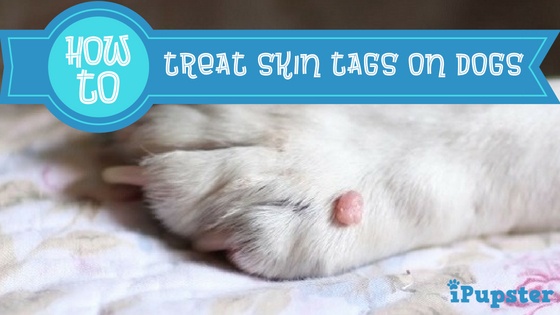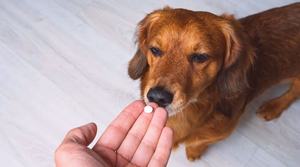Skin tags are those (usually) painless little flaps of skin that seem to appear on your body from out of nowhere. Skin tags can be small, only a few millimeters, or larger, measuring up to several centimeters in diameter. You may have seen commercials for skin tag removers on TV, like this popular one from Dr. Scholl’s.
What you might not know is that dogs can get skin tags too.
Noticing an abnormal growth of skin cells on any family member can be a scary thing. The common worry is that these growths might be cancerous.
If you’ve recently discovered a skin tag on one of your furry friends, that might have been the first thing that came to mind.
Luckily, skin tags are benign, non-harmful growths that can be annoying and a little unpleasant to look at but not much more.
Here are the facts and answers to some common questions about skin tags on dogs, in case you’ve started to find them on your own dog(s).
Symptoms, Causes and Diagnosis
According to Gary W. Cole, MD, FAAD:
skin tags are very common, but their exact cause is unknown.
One of the beliefs is that skin tags are formed via friction, when skin rubs against itself or clothing.
That’s why skin tags are more common in certain areas, like the neck and armpits. Skin tags are usually small, but some can grow bigger in size.
For the most part, skin tags are painless and nothing to worry about, but they can become irritated and/or infected which can hurt a bit. If they get cut, they can also bleed a lot.
Just like humans, any dog can wake up with a new a skin tag one day, but they are more common in aging dogs. The best policy when you notice a new growth on your dog’s skin is to get it checked by a veterinarian, just to be on the safe side.
What should you do if you find a skin tag-like growth on your dog’s eyelid?
In this situation, the best thing to do is get it checked by a vet who can take down the details of the skin abnormality. The decision of whether the skin tag should be removed is usually based on whether it is bothering the dog.
In the eyelid scenario, the skin tag could cause irritation, so it should be removed. If removed, you can send the skin tag to a veterinary pathologist to rule out cancer.
Treatment
As humans we can be a little self-conscious when skin tags appear on our bodies and want to remove them for aesthetic purposes.
Some of us get scared that they might be a sign of cancer and get them checked, but once we find out they’re benign aren’t bothered by them and let them be.
Since dogs can’t make this decision for themselves, as owners we need to make the decision for them.
If you really want to you can go through the trouble of getting rid of any skin tag you see on your dog, but that might not be necessary. If you get it checked to rule out and sort of malignant or dangerous growth, most skin tags can be left alone.
If a skin tag is causing your dog pain or discomfort because of the location or because they’re scratching, etc., removal is an option.
How do you get rid of skin tags on a dog?
There are several ways that you can get rid of skin tags on a dog. If you choose to do so at home there are a few options available, including tying the skin tag off or using remedies like Good Karma Naturals’ All Natural Wart Remover for Dogs.
If you choose to go to a vet for your dog’s skin tag removal, they will probably use one of the following techniques: cauterization, surgery, cryosurgery, or ligation:
Cauterization is the use of heat to destroy abnormal cells. It can be done using chemicals, a hot instrument, or electricity. This process results in the least amount of bleeding and the spot is usually numbed before the procedure.
Another option for skin tag removal is surgery, which entails using a scalpel to cut off the skin tag. This option is usually recommended for larger skin tags.
Cryosurgery involves the use of liquid nitrogen to freeze the skin growth. This process turns the area white and blocks blood flow, causing the growth to die and to fall off on its own.
The procedure only takes a few minutes but depending on the size of the skin tag it may take one or more sessions to work.
Ligation is a technique that involves clipping or tying a string around a skin tag or growth to cut off circulation, causing the growth to essentially die and fall off on its own.
Do they come off on their own?
Most skin tags seem determined to stick around until you do sometime to purposely get rid of them, but it is possible for a skin tag to come off on its own.
Usually this happens when the skin gets twisted and blood supply to the skin tag is cut off, so it falls off without the need for intervention.
Can dog skin tags be a sign of cancer?
It’s important that, as an owner, you can distinguish between a skin tag and actual signs of cancer. Skin tags are harmless.
Although they can get infected, bleed, and sometimes become painful when irritated, they are not cancerous and don’t mean your pet is more likely to get cancer.
According to Help Your Dog Fight Cancer: What Every Caretaker Should Know:
The most prevalent canine cancers are the various types of skin cancer (lumps and bumps in or under the skin), occurring at a rate of 450 per 100,000 dogs per year. This means that approximately 274,000 dogs are diagnosed with skin cancer each year. These tumors are often benign (e.g., lipomas) but can be malignant (e.g., mast cell tumors), so a specific diagnosis is necessary to determine the best treatment plan.
Aside from skin tags, dogs can develop benign (non-harmful) tumors called melanocytomas. Dog can also develop dangerous moles that are a sign of the skin cancer, known as malignant melanoma.
As an owner there are certain ways to spot these dangerous growths, but if you’re ever in doubt the best thing to do is bring your dog in to get checked.
One way to distinguish non-harmful from harmful skin growths on your dog is to pay attention to their behavior.
If other skin growths don’t bother your dog but suddenly, they start sniffing or scratching at one, it might be a sign that you should bring your furry friend to the vet.
A few other signs that you should get a lump on your dog checked to determine whether it’s cancerous or just a skin tag is if the lump grows rapidly or there are changes to the skin around that area, like irritation or a difference in color.
Knowledge is Power
Noticing abnormal or new skin growths on your dog can be a scary experience. The thing is, these growths can happen to any dog and they’re common in older dogs.
It’s important not to panic, but also essential that these growths are taken seriously in case they are cancerous. In many cases, skin growths on dogs are harmless skin tags that you dog can live with and don’t even need to be treated.
Of course, there are situations when skin tags may need to be removed.
For example, a skin tag on your dog’s eyelid that causes discomfort, or one that keeps getting scratched and infected. If this is the case, once your vet rules out cancer, you can have the vet remove your dog’s skin tag or you can remove the skin tag yourself, depending on how big it is.
The process of checking out your dog’s skin growths at the vet is easy. In most cases a small needle is used to take a sample of the growth to determine if it is benign or malignant.
From there, your vet will know what to do. If it’s a skin tag, methods like cauterization, cryosurgery, surgery, and ligation can be used.
There are also natural remedies that you can use at home to remove skin tags on dogs.
READ NEXT: How To Make Golden Paste for Dogs




